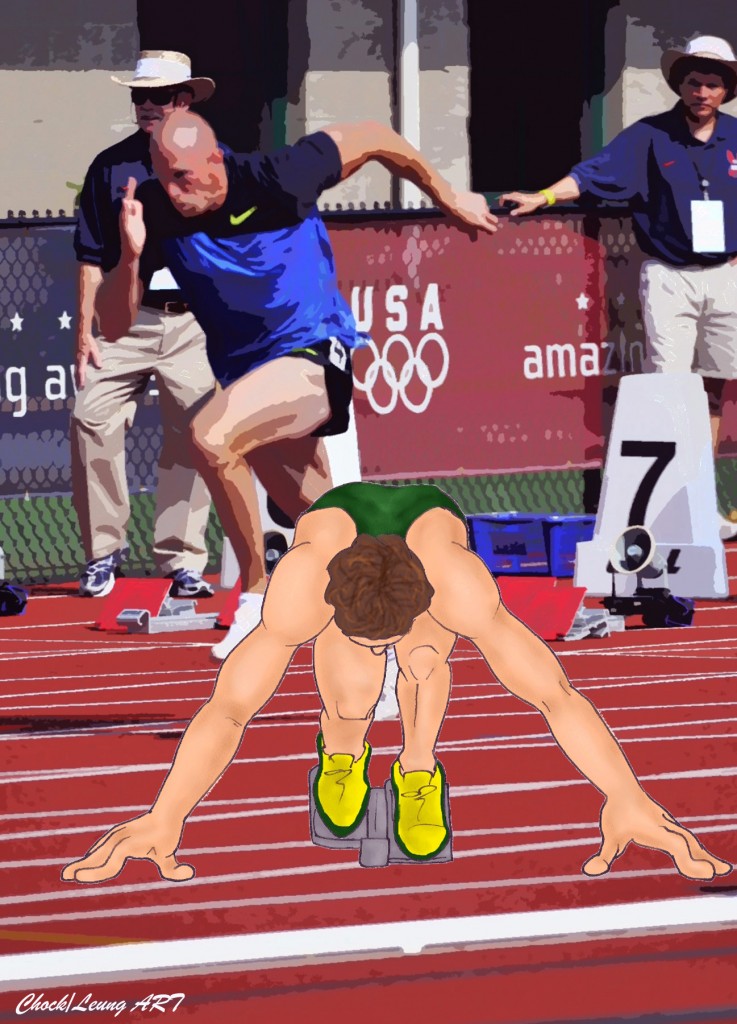Let’s talk some plyometrics.If you’re reading this and your face is already smeared with chocolate and Peeps sugar residue, you’ve done the Easter Bunny thing right. 😉 Just kidding…Happy Easter to those who celebrate and Happy Sunday to those who don’t.
But because we have bunnies on the brain today I thought it fitting we revisit the topic of plyometrics, this time covering hops and jumps. You can read the Part I on bounds and skips.
This time of year also falls into early track season; here is a prime time to build strength by incorporating plyometrics into your training. Plyo’s, because they are intense, fast-twitch muscle focused are taxing on the body and even if you don’t feel sore right away that will usually change come the next day. Because of this you have to be careful not to over-do them and typically you’ll want to ease back on these plyos, or cut them out entirely, come peak racing season.
During base building phases and early season is your opportune time to increase you strength and work on areas you need to improve on. If you’re not racing track, or not racing at all, plyo’s are still great because they:
1) Build strength and power; this translates into speed and the ability to end your races faster with a kick
2) Build more muscle; more muscle mass and less fatty tissue is always a good thing 😉
3) Rev up metabolism;similar to interval sessions, intense bouts of plyo’s not only get your heart rate up there while you’re doing them but they create an after-burn effect where your metabolism is elevated for hours after you complete the workout
Let’s get into the hops and jumping variety of plyo’s:
* Rocket jumps: Start standing with feet about shoulder width apart. Bend down into a squat and touch the ground with your hands and then blast up into the air, extending your arms up over your head. Reach for the sky and try to get as high off the ground as you can. Get back down into the squat and blast again. Start with one set of 10.
* Single leg butt-kicker leaps: Start balancing on your right foot and keep your left leg bent and off the ground for all of this jump. For this jump you want to achieve two things: clear as much distance as you can AND get your right leg up high into the air and kick your bum. You will look funny doing this, but that’s okay. Do 10 jumps on your right leg and switch to your left.
* Star jumps: Similar in look to jumping jacks, the star jump is different in that you will raise your arms and legs out at the same time. Start standing feet together and arms at your side; jump up into the air, kick your legs out to the sides and raise your arms up until they meet over your head. When you land you want you finish in the same position as you started. As you build power you’ll want to test yourself to see how high you can jump and how far apart you can get your legs during each jump. Do a set of 10 to start.
* Single leg step-up blasts: Find a bench that when you place your right foot on it your quad is about parallel to the ground and both knee and hip bent at 90 degrees. Start in this position and with you left leg still on the ground, step-up and transfer your bodyweight onto your right leg and swing your left leg up towards your chest as you go. Once you are standing on the bench keep the step-up momentum going and then blast off with your right leg into a jump. Try to jump as high as you can, land back down on your right leg and then lower down into the starting position. Your arms during this will swing in the opposite arm/opposite leg motion you do while running. Do a set of 10 with your right leg and switch to your left.
* Quick feet bench taps: Use a bench the same height as you did the step-up blasts; start facing the bench with both feet on the ground. Here you will alternate quickly tapping the bench with your right foot and then your left. You do this in a continued hopping motion; right tap, left tap, right tap, etc. The aim is to keep moving and to get those feet to fire off the ground, to the bench, and back down again as quickly as possible without losing balance. Your arms will follow the opposite arm/opposite leg motions you do as running. Start with a set of 20 toe-taps; that would be 10 taps for each foot.
These are 5 great jumping plyometrics to get you started in building a routine. If you’re new to plyo’s, remember it is QUALITY over QUANTITYand if you need to slow down or take longer breaks to complete them right that is better than doing more sloppily. Doing them with poor form will only re-instill bad habits and set you up for an injury. Secondly, for your first few times only do a set of 10, you may feel like it was ‘easy’ but typically you want to walk away from a session tired but not demolished; with plyo’s the fatigue sets in later and even if you don’t feel like it, the muscle tissues were broken down.

Do a plyometric routine after your hard workout day; finish your cool-down them move into those plyo's.
For runners, here are points to remember:
* Do plyo’s on days you already did a hard workout. It sounds off, but you don’t want to add plyo’s to your easy days because that will defeat the purpose, you’ll never recover and then come your hard workout days you’ll be spent and tired.
* Start with doing plyo’s only 2, up to 3, times a week with at least one day between them. Start with only 1 set of 10 for the first week, if not the first few, and work your way up to 3 sets of 10.
* Allow full recovery between each set. You want to be fully recovered between each set so you can give each jump the most power; you’re working on your explosiveness not your endurance here…channel your inner sprinter.
* Mix and Match: If you’re doing more than one plyo session a week, do jumps and hops one day and switch to the leaps and bounds routine the next time you do them. Get a good variety of what you’re doing, as with any other training philosophy.
Once you’re done with your plyo’s be sure to refuel like a champ within 30 minutes to get the recovery window!
1) What’s your favorite Easter type candy…are you all about the chocolate eggs, the Peeps, or were you one of those kids who actually looked for the real hard-boiled ones and ate those?
2) Do you do plyo’s and if so, which are your top picks? If you don’t, would you be willing to try them?
3) If you don’t do plyo’s, what do you do to work on your power and speed?
4) Anyone race this weekend?



Pingback: The Running Tax: What would Uncle SaMiles as you as payment of your annual running? |
Pingback: The Big Three: Talent vs. Work Ethic vs. Mental Toughness- Which matters the most? |
Pingback: A Runner: A beautiful blur |
Pingback: The Leg That Looked Like a Fish: When muscle weaknesses cause inefficiencies in your running |